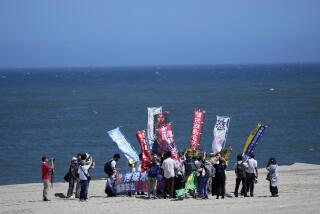Chernobyl Efforts ‘Colossal’: Soviets : Divers Braved Radiation to Drain Water Under Reactor, Officials Say
- Share via
MOSCOW — The Soviet media, describing “colossal work” going on to contain radiation at the devastated Chernobyl reactor in the Ukraine, reported that a nuclear catastrophe was averted last week when an underwater reservoir was drained with the help of volunteer divers who exposed themselves to heavy radiation.
The reports were published as one of the designers of the reactor said the facility must be sheathed for centuries in the concrete tomb now being built for it in order to neutralize its deadly radiation leaks completely.
Pravda, the official Communist Party daily newspaper, carried articles from the scene, 60 miles north of Kiev, describing the work that has so far averted further disaster and that must go on for months in order to decontaminate the plant area.
Full Meltdown Averted
Pravda quoted Yevgeny P. Velikhov, a physicist and vice president of the Academy of Sciences, as describing how a major threat of reactor meltdown was averted during the emergency procedures that followed the initial explosion and fire, which occurred early April 26. Many Western scientists believe that at least a partial meltdown did occur.
Velikhov said the damaged reactor, pressed down from above by thousands of tons of sand, lead and other fire-extinguishing materials, was in danger of plunging into an underwater reservoir, which would have released radioactive steam into the atmosphere.
“How would the red-hot core behave?” he asked rhetorically. “Will we manage to hold it suspended or will it go down into the earth? No one ever in the world ever found himself in such a situation before.”
But the efforts of scientists and engineers proved successful, and the crisis passed on Sunday, he told Pravda.
Velikhov said water was pumped from the reservoir, a cooling zone was set up to absorb the reactor’s heat and the process of encasing it in concrete was begun.
The newspaper Soviet Russia said Yevgeny Ignatenko, deputy director of the national nuclear energy agency, volunteered with four other specialists to dive into the tank with special scuba apparatus in an attempt to drain the water.
Dozens of Roentgens
They accomplished their mission, Ignatenko told the paper, although he received dozens of roentgens of radiation, a dose that is more than double the limit for a nuclear plant worker for an entire year.
“Nothing special about this,” the paper quoted him as saying. “We have people here who have more (radiation) than that.”
For the first time in two weeks, the Soviet government made no official announcement Tuesday regarding the progress of cleanup operations at Chernobyl.
The disaster, the worst nuclear accident in history, has claimed at least six lives and injured at least 200. The Soviet government reported on April 29 that two people were killed in the explosion and fire at the plant, and it said Monday that six people died from burns and radiation.
While this appeared to be a total of eight deaths, Ivan P. Yemelianov, deputy director of the state construction firm that designed the No. 4 reactor at Chernobyl, told West European reporters Tuesday that the death toll was only six. The confusion was attributed to the ambiguous wording of Monday’s announcement by the Soviet Council of Ministers.
“The reactor has not yet been rendered harmless, and radioactive substances are still present at the station and in the (19-mile danger) zone,” said Deputy Premier Ivan S. Silayev. “Work with them requires considerable caution and thoroughness.”
Silayev said a special coating was applied to the roofs of buildings as well as the ground to prevent penetration by radioactive substances.
Plugging Possible Openings
At the same time, military helicopters bombarded the reactor with lead shot to plug any possible openings that could allow radiation to escape, Silayev was quoted as saying in Izvestia, the official government newspaper.
“As seen from the readings of instruments, the level of release (of radioactive material) is steadily lowering,” Silayev told the newspaper.
Yemelianov told the West European reporters that it will be centuries before the reactor is considered free of radiation hazard. The other three reactors at Chernobyl will be started up again as soon as the area is decontaminated and work is completed on the thick concrete tomb that will sheathe the damaged reactor, he said.
Yemelianov said he still has faith in the Chernobyl design despite the accident. He said its safety systems were planned to cope with human error and still avoid radiation leakage.
Gorbachev Talk Due
After 17 days of silence on the disaster, Soviet leader Mikhail S. Gorbachev scheduled a speech for today without indicating his topic.
Diplomats speculated that the Kremlin chief would discuss Chernobyl for the first time since the accident raised radiation levels in most of Europe and triggered condemnations of Soviet secretiveness.
Gorbachev’s plans were announced on Vremya, the main evening television news program, after Boris Y. Shcherbina, head of the government’s Chernobyl investigation, held a briefing at which he told diplomats from 15 nations that leaks of radioactivity from the damaged reactor have almost stopped.
Meanwhile, American industrialist Armand Hammer flew into Moscow with a planeload of medical supplies to help in treatment of radiation victims. He said the Soviets were “coping well” with the aftereffects of the accident.
Hammer, who has dealt with the Soviets for many years, brought the medicine and equipment for the use of a team of three American specialists and an Israeli who are performing bone marrow transplants on radiation victims.
More to Read
Sign up for Essential California
The most important California stories and recommendations in your inbox every morning.
You may occasionally receive promotional content from the Los Angeles Times.













